I was raised in a progressive, politically-aware family, but we weren’t particularly active. When I’ve asked my mother about how her politics developed, she’s told me that they couldn’t until my sister and I were out of the house. She knew how she felt, but when we were young, it seemed like a full-time hobby for her to stay current. I’m sure many working families in this country, with or without children, feel the same way.
The Protests That Changed Us
Still, I remember my mother’s small shows of activism throughout my childhood. When my sister and I told her that a youth group meeting had been devoted to lecturing us on the ‘evils of abortion,’ she pulled us out of it. When a man with a critical handicap attempted to cross in front of our car, my mother held up traffic so she could help him. When she noticed a family walking home every day from church in the winter, she began showing up at their home every Sunday morning to offer a ride.
That was my mom. Those were her politics, and they’ve shaped my own. Today, my mother’s activism has only become more fine-tune. She’s left a church that she grew up attending because she couldn’t bear to listen to another anti-LGBTQ or anti-choice homily. She sets money aside every year to donate to Planned Parenthood instead. She will not pass up any opportunity to engage with someone on climate change, marriage equality, reproductive justice. And on Jan. 21st, her and my father will attend the Women’s March on our state capitol of Augusta.
On that same weekend, I’ll take a bus from Mount Desert Island, Maine to Washington D.C. to attend the same march. I’ll join what is expected to be more than 200,000 other people, of all backgrounds, to prove to the incoming administration that we exist.
Like my mom, I’ve committed my short life to small actions. In college, I threw myself into feminism. I started a newspaper that still exists on campus today. I went to Student Women’s Association meetings every week. On Wednesday mornings I stood with several others in silence, holding pro-choice signs, across from a geology professor who held his own morbid and irrelevant images.
Each time I’ve participated in these small acts, I’ve come away with a feeling of accomplishment. So in preparation for the Women’s March on Washington, I reached out to the Matador community for protest stories. I wanted to see if others came away with a similar sense of power, no matter how small their action. Here’s what I’ve gathered.
Oakland, California
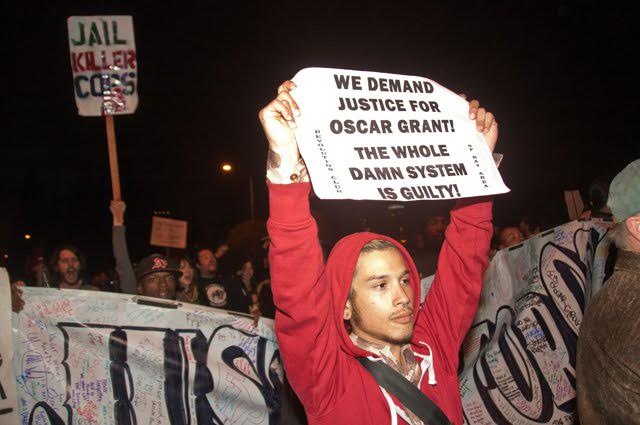
Photo by Miguel Gongora
It was the end of Dec. 2009 in Oakland, California and people were getting ready for the new year. It seemed like an ordinary New Year’s Eve, until the next day when video footage of Oscar Grant’s murder was released. Oscar was shot at the Fruitvale BART station, my neighborhood at the time. A cop had shot him down, point blank on the ground. The atmosphere in Oakland turned heavy after that, people were angry all over — in the streets, in the restaurants, in the schools, everywhere.
How could you not be upset at what this video showed?
In the following days, that anger finally burst. And even though I wasn’t from Oakland, and I was not born in the U.S., I felt like I needed to join the protests with these people demanding justice. I thought it was righteous to fight for this justice. I felt that it was the right thing to do. Oscar Grant could have been me or someone I knew. For the first time in almost eight years since coming to the U.S., I was afraid. I finally understood that for people of color, encounters with police could turn fatal in a matter of seconds. I still remember what people were chanting in the streets: “The whole damn system is guilty.” It was an indictment of the entire system, not just one rogue cop.
Looking back at what happened then, I realized that I had witnessed the struggle of two very powerful forces. I had a glimpse of what could decide the fate of humanity in the future: the American people vs. the state apparatus. — Miguel Angel Gongora
Standing Rock Sioux Reservation, North Dakota
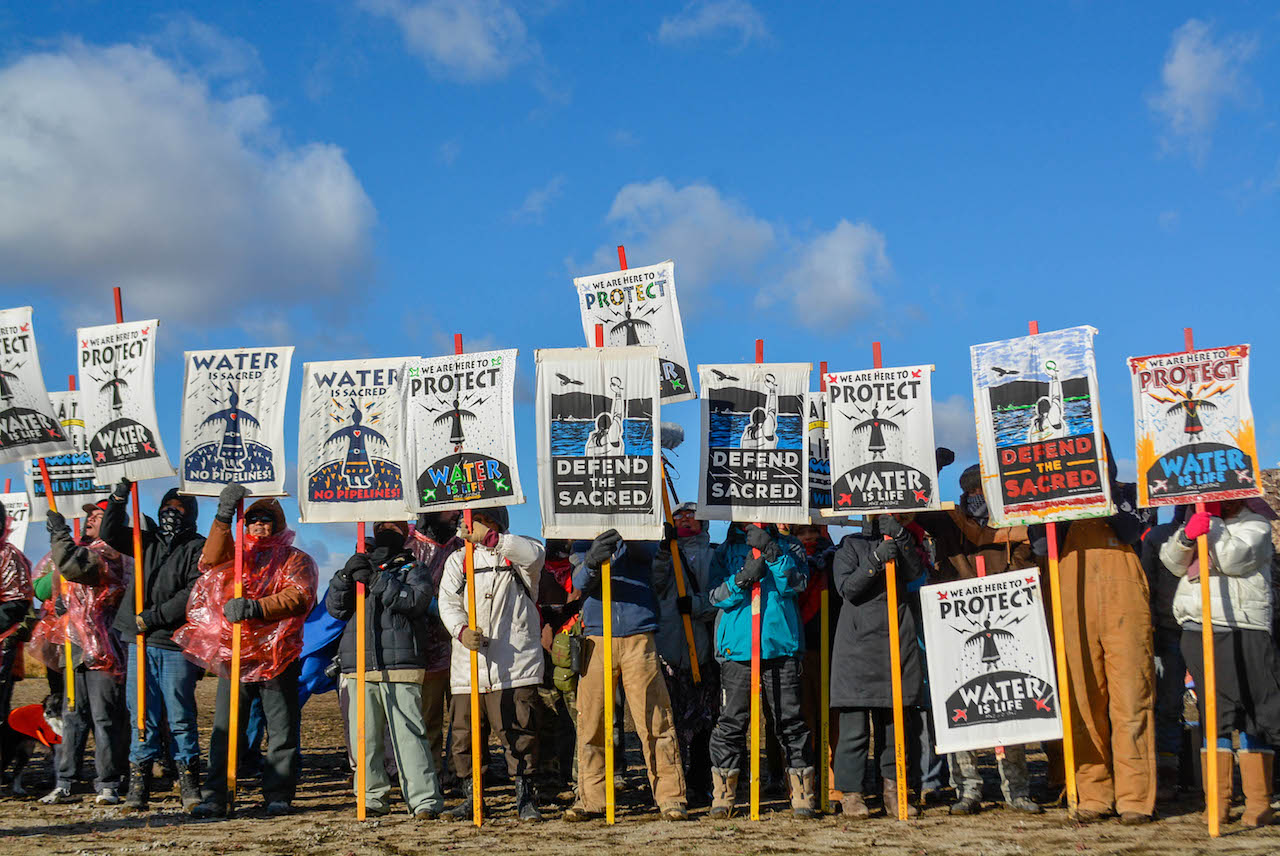
Photo by Matt Koller
“It feels like not too long ’til we could see Indians hanging from trees,” said our waitress, half native, half white, in a Casino 80 miles south of Standing Rock.
“Have you been at camp?” S asked.
There were seven of us traveling, each of us searching for our own reasons. S was a former veteran and a seasoned activist, itching to participate in a fight. There was a college professor, taking everything in with stunned eyes, and our driver, a no-nonsense wonder-mechanic who had organized this expedition because he was “tired of sitting around on his hands.” I was going because I thought the future of movements in America could be decided by what happened here.
“No. Some of us gotta pay bills,” she replied. “They’re doing a good thing but it’s hard on everybody. Bismarck’s the one place we can buy Christmas gifts, and they won’t sell to us now.”
In the morning we rumbled north.
We were there less than 24 hours. It was December 7th. The camps had just metabolized 2,000 veterans, the easement denial (a fragile victory), and the first true blizzard of the great plains winter. So we whirled through a whirlwind, dropped off our supplies, made spaghetti for the camp, and picked up a handful of water protectors needing to return west.
And then we were back on the bus. S read a post about a hate crime in Bismarck from that morning. Like me, he had wanted to stay, but because of default-world obligations he didn’t. I knew what he was thinking: “If we couldn’t stay, why did we come?” A somber silence churned at the question.
And then, as if coming out of an otherworldly trance, our new passengers began to share their Standing Rock stories. We huddled around them at the back of the bus. “Why did we go…?” We went to listen. — Nikita Nelin
Flagstaff, Arizona
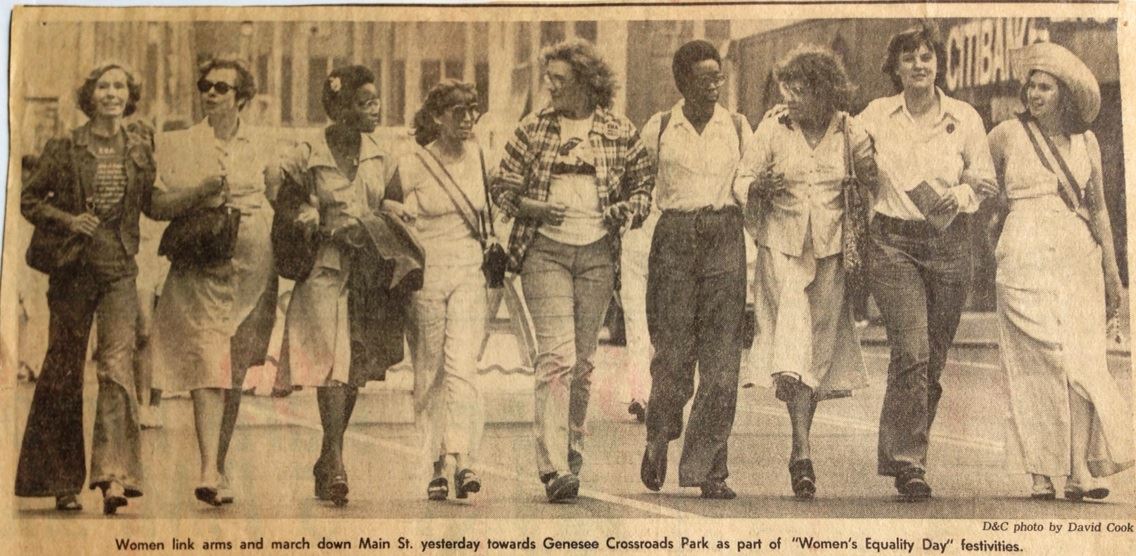
Photo by Mary Sojourner
I first spoke out against injustice 60 years ago. A clique of kids from wealthy families ran my high school. They were always prom queen and king, and officers on the student council. None of them ever showed up for the hard work of planning and pulling together the proms or for serving on the audience. I ran for secretary of the Student Council. At the election rally, I tore up my approved speech and said to the packed auditorium, “We who do the work in this school, know who we are. If I am elected secretary, I promise all of us that we will have the power.”
Fifty years later, I fought for twelve years to stop snow-making with dirty water on the sacred mountain that rises north of Flagstaff, Arizona. Again, a few hard-working people showed up for every demo, witness, hearings and civil disobedience. I learned to have nothing but contempt for the “nice” earnest people who stopped me in the street and said, “Thank you and your friends for the work you do. I’m completely with you, but protesting is just not my thing.” At first, I’d smile and thank them. After a while, I’d say, “You know the band R.E.M.’s song, Stand in the Place Where You Live? Check this out:
Stand in the place where you live
Now face north
Think about direction
Wonder why you haven’t before.” — Mary Sojourner
Washington D.C.
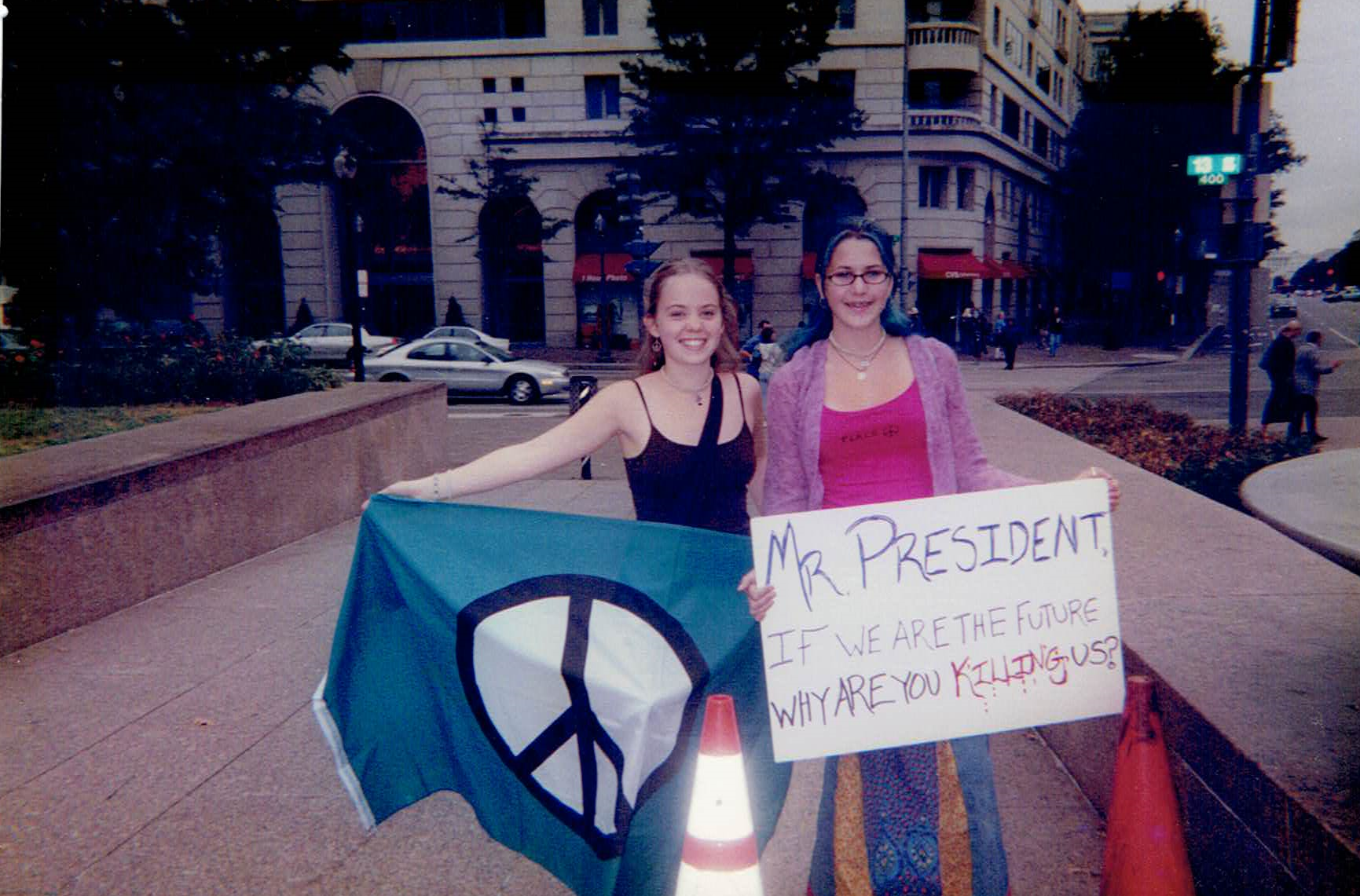
Photo by Hazel Stark
Our sign said, “Mr. President, if we are the future, why are you killing us?” Bonded by teenage friendship, excitement, and adrenaline due to our shared journey to make a statement in our nation’s capital, we took a bus full of like-minded activists from Bangor, Maine to Washington D.C to attend the September 2005 March on Washington to protest the Iraq war. When we arrived, we were quickly overwhelmed by the sheer number of people present. All shreds of excitement quickly morphed into a powerful feeling of solidarity matched with deep anger that this war had ever begun.
We marched, sang, and chanted with an estimated 300,000 people. Protests occurred all over the world on that day, showing that people, in fact, were paying attention to the effects of the US war on Iraq. But the subsequent lack of media coverage left me feeling that we, the people, were not being paid equal attention.
They say “an ounce of prevention is worth a pound of cure.” When the march ended, I was left wondering how such a powerful event fit into that equation. That March on Washington did not end the war on Iraq, but it did leave at least one 16-year-old girl with the profound understanding that while a protest is an important type of cure, it is our daily preventative actions that will always be more impactful. I stopped asking, “how can we stop wars?” and began to consider, “how can we prevent them?” — Hazel Stark
New York City, New York
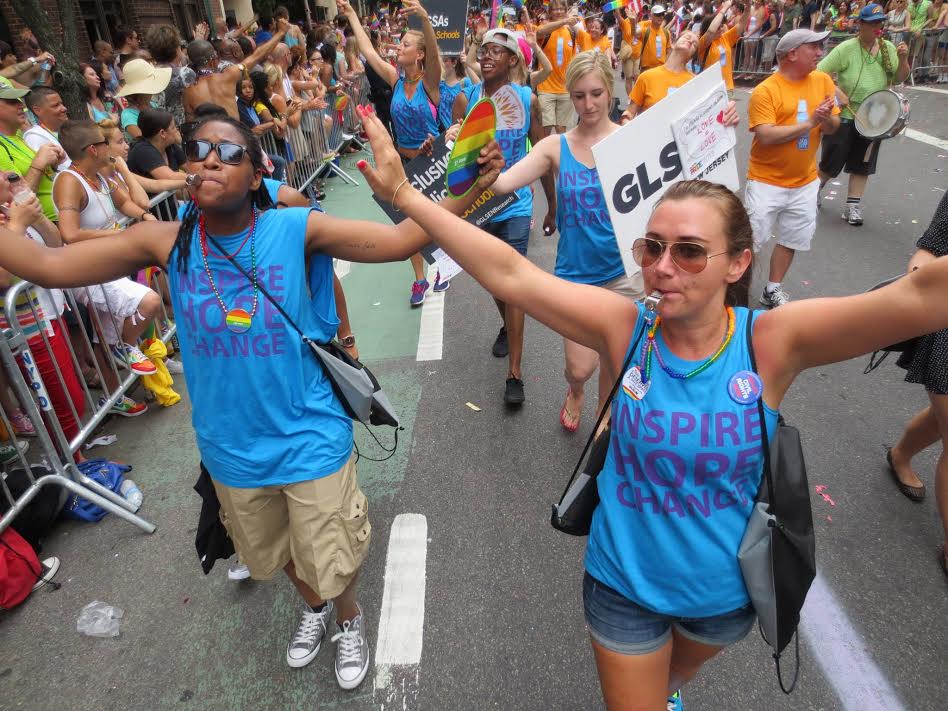
Photo by Meg Cale
As a professional LGBT advocate, I’ve been involved in many demonstrations. The one that sticks out in my mind was during the time of Occupy Wall Street. It was one of the first marches to Union Square of New York City. The cops had started using plastic orange fencing to “kettle” the protesters — it’s a technique where they form a maze with the plastic to reduce access in and out of the encampment. The police were screaming at the demonstrators to move off the sidewalk, as I was running to get out of the way I looked behind me into the crowd and saw a black teenage girl get swept off her feet by the fence. She landed on her face and blood immediately started pouring from her nose and mouth. The cops completely ignored her and kept dragging the plastic fencing over her body as her friends screamed for help. I was 21 years old. It was the first time I realized that cops don’t protect everyone.
Another time:
I was working for a nonprofit that supported LGBT young people, also in New York City. One of our volunteers was an older man with multiple physical disabilities. We were demonstrating for marriage equality that day. The goal was to block traffic with a banner until the protesters were arrested. I was part of the team who’d act as witnesses for social media. The volunteer was there to sit in the street to block traffic with several other demonstrators. When the police showed up, they asked them to move several times before slowly starting to drag each person off the street and arrest them one by one. The volunteer was the last person left in the street. Cameras were flashing as the police approached him and gave him the opportunity to leave the road on his own. He refused and demanded to be arrested with the other activists. I will never forget the look of smug satisfaction on his face as he lay limply in the officers’ arms as they carried him to the curb and handcuffed him. — Meg Cale
Seoul, South Korea
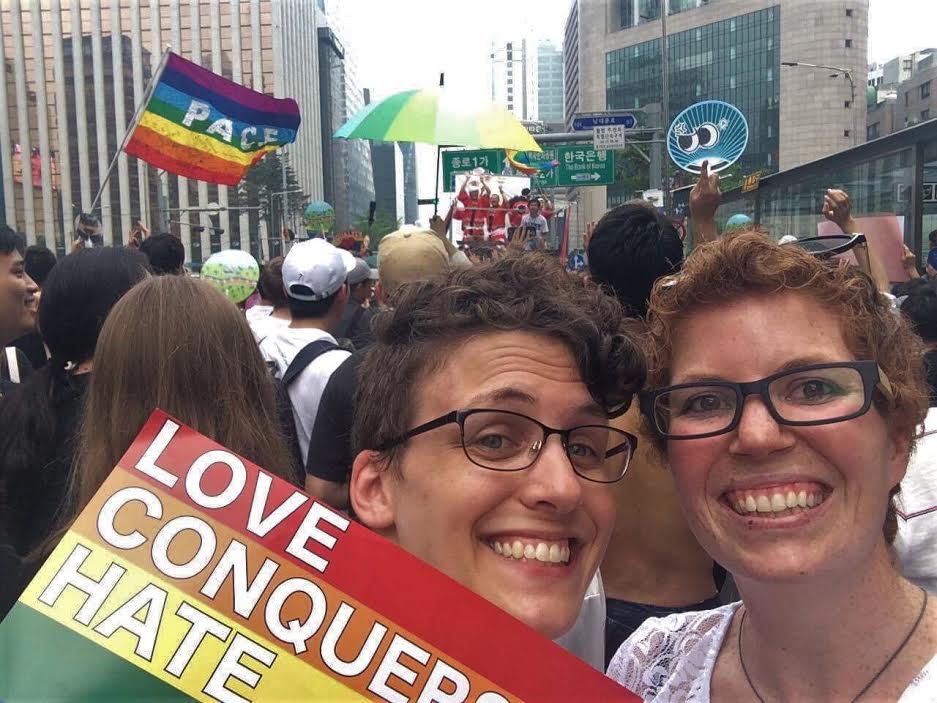
Photo by Alexis Stratton
As I rode the escalator out of the City Hall subway stop in Seoul, music filled my ears. But as celebratory as the music sounded, I realized that it was coming from anti-LGBTQ protesters gathered outside of the station singing songs about Jesus. More people across the street yelled with words I didn’t know but a message I could understand.
I pushed past people crying and praying and crossed lines of police in neon yellow vests to enter City Hall Plaza, where I was surrounded by rainbows and smiles and signs that said things like Love Conquers Hate. And as the audience pressed up against the stage, bouncing in time to the beat of the music, a feeling of closeness wrapped around me.
I didn’t think I would see this in South Korea — I hadn’t known this when I’d lived there ten years before when I wasn’t even out to myself. But here I was, surrounded by people who were willing to say not only “we exist” but also that we’re proud and beautiful and loved.
Thousands marched through Seoul that hot June afternoon, protesters shouting from all directions as police in riot gear jogged alongside us. But as we moved deeper into the city, the number of protesters thinned, and instead, people waved and said “Happy Pride!” and marchers belted out anthems that were blasting from floats—“We Are Family” and “I Will Survive.”
I sang along, knowing we would do so much more than survive. — Alexis Stratton
Boston, Massachusetts
It was one of those early Spring days in Boston when you find yourself stripping off a layer as you walked in the sun and putting it back on as you walked in the shade. I walked with a group of 50 or so women and a few sympathetic men from the imposing, angular gray Boston City Hall building to the gold-domed, colonial brick Massachusetts State House. We walked for the Boston Walk for Choice. Our journey was in protest to Congress’s plan to defund Title X, and therefore, Planned Parenthood.
Planned Parenthood is the only option for many poor and middle-class women to receive affordable women’s health care. I myself have been able to afford sexual healthcare because of this organization. As we marched and chanted along the historic cobblestone streets with names like Congress Street, State Street, and Court Street, the Budget Control Act of 2011 and its spending caps on federal programs loomed threateningly.
Protesters held up signs that said: “Because of Planned Parenthood, I’ve never needed an abortion”. And: “Family Planning is Fiscally Responsible”. These messages were meant to raise awareness, to combat the moral panic that anti-choicers are still trying to create. We wanted to enforce the fact that no, Planned Parenthood isn’t an abortion factory.
“They want to cut $330 million,” said organizer and speaker Liz Waters as she occupied the steps in front of the State House. “These measures are anti-women and anti-family.”
There’s a nationwide attack on women’s rights and the rights of all people to sexual and reproductive health,” said another organizer Elizabeth Gentry, who went on to condemn the national effort to restrict women’s rights to abortion, as well as the coordinated effort of the Republican Party to rile up the base for the next election.
I stood with these women, pained that we still had to fight for our rights, but ready, with fists clenched at my sides and throat raw from chanting, to keep the fight going. — Rebecca Bellan
Orlando, Florida
Even though I’m not LGBT, I’m an ally and I marched in my first pride parade this past November. I marched because I was raised in Orlando, Florida and I’m of Hispanic descent. The attack on Pulse Orlando had shaken me and I wanted to help — more than half of those killed at Pulse were Latinx. And when the Westboro Baptist protestors started disrupting the funerals of the Pulse victims, my sadness for those lost and hurt turned into action. Enter: Angel Action Wings for Orlando. These seven-foot angel wings made of PVC and white fabric have brought much comfort to our community — gay or straight — and I am proud to be a small part of their legacy.
My first Come Out With Pride experience was extraordinarily welcoming and warm. Pride 2016 fell on the 5-month anniversary of Pulse and emotions were still high. People were still clearly hurting but they were also in desperate need to just celebrate and have fun. I witnessed my adopted hometown of Orlando — its citizens, visitors, government, law enforcement, schools, sports teams, and businesses — unite in solidarity, in beautiful ways that I had never seen before June 12. If there was any sort of silver lining to this tragic story, it’s the fact that we’ve STAYED united these seven-plus months later.
Our Angel Action Wings group of volunteers, locally founded by Orlando Shakespeare Theatre, marched that weekend with all of Central Florida Macy’s employees. When our group of 49 angels rounded the corner, a hush fell over the tens of thousands of loud and proud parade spectators. Many of my fellow angels formed hearts with our hands as we marched. We blew kisses to young and old. Many of us received hugs from spectators as we walked past them; a thank you for volunteering. The overwhelming hush that fell over the crowd was quickly followed by loving applause, loud cheers, verbal declarations of love and tears. I will never forget that feeling. — Jen Vargas
Pittsburgh, Pennsylvania
The first time I ever protested I was sixteen. I did not make signs or camp out with other protestors. I did not need to gain energy from similar actions around the country, although there were plenty. I had enough energy in my own anger and I protested alone, passing by BP stations and demanding that my friends do the same if I was in the car.
My friends in unaffected Pittsburgh mostly rolled their eyes, but they appeased me. They knew I had moved from Pensacola, Florida not too long ago. I had walked on those beaches. I became sick to my stomach seeing the oil-slick seaside on the news — and it’s this feeling that I remember years later: the feeling of powerlessness and personal hurt. I was still boycotting long after the well-publicized clean-up efforts and the real threat of fines and litigation were doing much more harm to BP than my tiny boycott ever could. I wrote a college admissions essay on the topic of the hypocrisy I felt driving a car and about how personal experience informs political philosophy (albeit, my lucidity on the former topic far exceeded my ability to argue the latter).
I’ll still make the argument, today, though. I’ve seen it again and again as I participate in more traditional protest movements. I’ve picketed and marched, once participated in a flash dance — but the roots of every form of protest seem to me to be the same individual sickness and sense of powerlessness. The beauty of an effective protest movement is that it can give our individual hurts an external reality. Only then it becomes clear we can also make real our ideals. — Alexandra Marx
Kootenays Region, British Columbia
For nearly 25 years, the locals in the Kootenays region of BC, including the First Nations community, have been fighting against the development of a massive ski resort in the Jumbo Valley. If built, this resort would scar a pristine wilderness and effectively close a natural wildlife corridor, most notable for its grizzly bear population. Even with a very vocal opposition, that has extended across Canada, the BC government approved the ski resort project.
I live in Nelson and have been to street protests, I’ve signed numerous petitions, and I’ve noticed a solidarity that has developed within our surrounding communities — a great number of vehicles in the Kootenays sport “I ♥ Jumbo Wild” stickers. The efforts have sparked a well-made documentary, “Jumbo Wild,” which is now available on Netflix (or for rental on YouTube). The fight in the Kootenays is still ongoing but it’s been successful so far — the development of the resort has slowed down to a crawl, which has bought activists time to completely shut it down. Our local Minister of Parliament, Wayne Stetski, has even brought the issue to the highest levels of the Canadian government. — Carlo Alcos